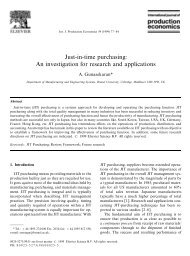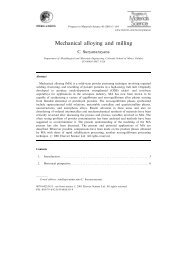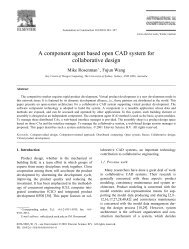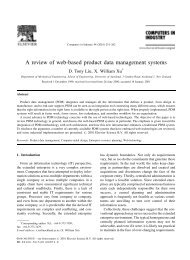Internet-based intensive product design platform for ... - GRACO
Internet-based intensive product design platform for ... - GRACO
Internet-based intensive product design platform for ... - GRACO
You also want an ePaper? Increase the reach of your titles
YUMPU automatically turns print PDFs into web optimized ePapers that Google loves.
Fig. 4. The flowchart of searching support part on function driven.<br />
from its repositories. To this purpose, a method of<br />
knowledge search <strong>based</strong> on a function driven concept and<br />
an Artificial Neural Networks (ANN) technique is proposed<br />
in this paper.<br />
5.1. Function driven<br />
Designing and developing a <strong>product</strong> is system engineering;<br />
it refers to multi-discipline knowledge. Even <strong>product</strong>s<br />
with a single function or certain phases within the<br />
development of a <strong>product</strong> require the support of various<br />
kinds of knowledge. A <strong>design</strong>er could not master all of the<br />
necessary knowledge, or at least could not reach an expert’s<br />
level in all those disciplines. Certainly, he could not employ<br />
a knowledge that he does not completely know. This means<br />
that much knowledge may be familiar to, but not mastered<br />
by the <strong>design</strong>er though he may know the function and<br />
constraints of this knowledge. Based on this viewpoint,<br />
the IPDP proposes a method of knowledge search. That is,<br />
the knowledge is searched according to the functions of the<br />
knowledge, here called Function Driven Knowledge Search<br />
(FDKS). With this method, when a <strong>design</strong>er needs a piece of<br />
knowledge he determines the function of the knowledge and<br />
the constraints that the knowledge requires. Then the IPDP<br />
searches <strong>for</strong> the knowledge in the repositories and retrieves<br />
it, matching the required functions and constraints. For<br />
example, suppose that a <strong>design</strong>er needs a rotative support<br />
part when he develops a <strong>product</strong>, and the part does not exist<br />
inthedatabaseofhis<strong>design</strong><strong>plat<strong>for</strong>m</strong>.Hewantstogain<br />
it from the outside repositories. Obviously, he does not<br />
know the details of the part. But he knows the functions<br />
of the part and the constraints that the part should meet.<br />
Since the IPDP provides the (FDKS) method, the<br />
<strong>design</strong>er only needs to provide the function and<br />
constraints that should be met. The IPDP then returns<br />
to the <strong>design</strong>er the resulting part that coincides with the<br />
user’s requirements. By this means, the <strong>design</strong>er can<br />
gain the knowledge that meets his <strong>design</strong> requirements<br />
even if he is not very familiar with it. The flowchart of<br />
S. Zhou et al. / Knowledge-Based Systems 16 (2003) 7–15 11<br />
searching the support part <strong>based</strong> on function driven<br />
knowledge is shown in Fig. 4.<br />
5.2. Back propagation neural networks<br />
Knowledge search driven by function requires the user to<br />
determine the function and constraints that the knowledge<br />
should meet. In many situations, a <strong>product</strong> (knowledge) has<br />
several functions, and the same function can be achieved<br />
with various <strong>product</strong>s (knowledge). Moreover, the repositories<br />
have a great deal of knowledge and the mapping<br />
relationships between function and knowledge are implicit<br />
and nonlinear. In these situations, it is very difficult to<br />
construct all mapping relationships through general mapping<br />
(e.g. rule reasoning). Then how does the IPDP<br />
efficiently implement the mapping between knowledge<br />
and the function of knowledge? To solve this problem, an<br />
ANN method is applied to construct the mapping relationship<br />
between functions and knowledge in the IPDP system.<br />
In 1986, D.E. Rumelhart, J.L. Meclelland of MIT<br />
University put <strong>for</strong>ward a Back Propagation (BP) algorithm<br />
of multi-layers feed <strong>for</strong>ward ANN. The BP algorithm solved<br />
the modeling problem <strong>for</strong> layer-networks, and realized the<br />
ANN used in engineering applications. Until the present the<br />
synapses of ANN have almost reached all fields of<br />
engineering application, such as machine vision, class of<br />
decision [12], intelligent control and fault diagnosis [13].<br />
Since the feed <strong>for</strong>ward neural networks with two layers<br />
(containing a hidden layer) were applied in class and curve<br />
approximate fitting, a two-layer BP neural network with a<br />
momentum coefficient is adopted here to construct the<br />
mapping relationships between functions of knowledge and<br />
knowledge itself. The mathematical model of BP neural<br />
networks is shown as follows.<br />
Training samples are {ðXp; DpÞlp ¼ 1; 2; …; N}: Here, Xp<br />
is the Pth input value of training samples. Xp ¼<br />
ðx p p<br />
1 ; x2 ; …x p a Þ: Dp is the Pth ideal output value of training<br />
samples, Dp ¼ðd p p p<br />
1 ; d2 ; …dL Þ: Yp is the Pth actual output<br />
value, Yp ¼ðy p p p<br />
1 ; y2 ; …yL Þ:<br />
To the Pth group of training samples with N groups, the<br />
input and output models of the hidden layer are stated as<br />
Eq. (1). The input and output model of the output layer are<br />
stated as Eq. (2).<br />
net p<br />
XM<br />
j ¼ Wijx i¼0<br />
p<br />
i<br />
o p<br />
8<br />
><<br />
ð1Þ<br />
>:<br />
p<br />
j ¼ f netj 8<br />
><<br />
>:<br />
net p<br />
k<br />
y p<br />
k<br />
¼ XS<br />
j¼0<br />
¼ f net p<br />
k<br />
W jko p<br />
j<br />
Select Sigmoid function f ðuÞ ¼1=½1 þ expð2uÞŠ as the<br />
active function of the BP neural networks. The valve values<br />
ð2Þ






